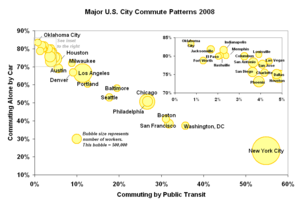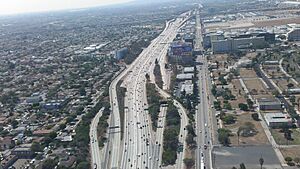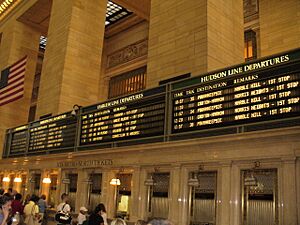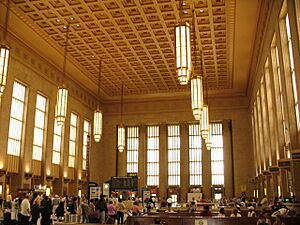Transportation in the United States facts for kids
The United States has many ways people and goods travel. Most people travel shorter distances by car. For longer trips, they often fly or take trains. Most goods are moved by trains, trucks, pipelines, or boats. Air shipping is mostly for things that spoil quickly or need to arrive very fast. Transportation is the biggest source of greenhouse gases in the U.S.
Contents
- Who Owns and Manages Transportation?
- How People and Goods Travel
- Safety on the Road
- History of Transportation
- Road Transportation
- Air Transportation
- Rail Transportation
- Public Transportation (Mass Transit)
- Water Transportation
- Military Transportation
- Pipelines
- Transportation Policy
- How Transportation is Paid For
- Economic Impact
- Environmental Impacts
- Images for kids
- See also
Who Owns and Manages Transportation?
Most roads in the United States are owned and cared for by state and local governments. Roads on federal lands, like national parks or military bases, are managed by the federal government. The Interstate Highway System gets some money from the federal government, but states own and maintain these highways. There are also a few private roads that charge tolls to help pay for their upkeep. Many local private roads serve homes in remote areas.
Passenger and freight train systems, bus services, and water ferries can be owned by either public groups or private companies. All civilian airlines are privately owned. Most airports are run by local governments, but some are private. The Transportation Security Administration (TSA) has been in charge of security at most big airports since 2001.
The U.S. Department of Transportation (DOT) helps manage and fund almost all transportation. However, things like customs and security are handled by the U.S. Department of Homeland Security. Each state has its own Department of Transportation. These state departments build and maintain state highways. They might also run or oversee other types of transportation.
Rules for flying are mostly set by the U.S. federal government. Car traffic laws are made and enforced by state and local governments. This is different unless the roads are on federal land. The United States Coast Guard is the main group that enforces laws and keeps U.S. waterways safe.
How People and Goods Travel
How People Travel
Most people in the U.S. travel using a huge network of highways. This network is over 3.9 million miles long! Cars, trucks, vans, and motorcycles are the most common way people travel. They account for about 86% of all miles traveled by passengers. Planes, trains, and buses handle the other 14%.
Public transportation, like subways and buses, is used a lot in big, older cities. For example, in New York City, more than half of all trips are on public transit. Airlines carry almost all people traveling long distances between cities. The main exception is the Northeast Corridor (between cities like Washington D.C. and Boston), where Amtrak trains carry more passengers than all airlines combined.
The United States has more vehicles per person than any other country. There are about 865 vehicles for every 1,000 Americans. Not many people use bicycles to get to work. In 2012, only about 0.61% of American workers rode bikes to their jobs.
How Goods Travel
Goods are moved around the U.S. using different methods. Trucks carry the largest share of freight by weight, about 60%. Pipelines move about 18% of goods, mostly liquids and gases. Trains carry about 10% of the weight, but a much larger share of the total distance goods travel (ton-miles). Ships carry about 8%, and air transport carries a very small amount, only 0.01%.
Air shipping is usually only for things that spoil quickly or need to be delivered very fast. Trains are very efficient because one train can pull many freight cars. This means they can carry huge amounts of goods over long distances. Trucks carry more total weight because there are so many of them.
Most cargo, except for oil and other bulk items, arrives in containers at seaports. Then, it is moved by road and rail across the country. The United States Postal Service handles letter delivery. However, private companies like FedEx and UPS compete to deliver packages and other cargo.
Safety on the Road
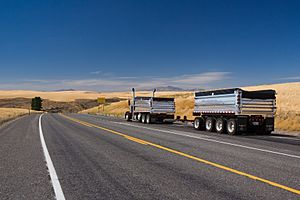
Safety is a big concern in transportation. In 2014, there were 33,736 deaths from motor vehicle accidents in the U.S. This was slightly more than the number of deaths from firearms that year.
In 2020, there were about 38,680 road deaths in the U.S. This was much higher than in the European Union, which had about 18,800 deaths.
Here's how safe different ways of travel were between 2002 and 2007, based on deaths per billion miles traveled:
| Mode | Passenger deaths |
Passenger-miles (millions) |
Deaths per billion miles |
|---|---|---|---|
| Passenger |
127,124 | 15,958,620 M | 7.97 |
| Light rail | 79 | 9,980 M | 7.92 |
| Motor bus | 399 | 117,982 M | 3.38 |
| Commuter |
105 | 59,736 M | 1.76 |
| Heavy rail |
106 | 86,900 M | 1.22 |
| Railroad |
36 | 33,234 M | 1.08 |
| Airline | 113 | 3,326,286 M | 0.03 |
Airlines are shown to be the safest way to travel per mile.
History of Transportation
Early Days (18th Century)
In the late 1700s, people traveled over land mostly by horse. For water travel, they used sailing ships. Most people lived along the Atlantic coast, near natural harbors or rivers. Because there weren't many people between cities, people relied a lot on shipping along the coast and on rivers.
The government first spent money on roads to help deliver mail faster. An example is the Boston Post Road between New York City and Boston. Because roads were expensive to build and keep up, many early roads were private toll roads called turnpikes. Other roads were often rough and hard to use with wagons, especially during certain times of the year. In the late 1700s and early 1800s, building canals became popular to move goods to markets faster. The Erie Canal was a very successful example of this.
The 19th Century: New Inventions
The 1800s, during the Industrial Revolution, saw many new ways to travel. Canals quickly replaced turnpikes and wagon routes. Then, steam-powered riverboats took over from canals. Artists like Samuel Colman showed this change. His painting Storm King on the Hudson (1866) shows both old sailboats and new steamboats on the Hudson River.
Access to water transportation shaped where early towns were built. For example, the Erie Canal led to a border dispute between Ohio and Michigan. The Erie Triangle was given to Pennsylvania so that state could reach Lake Erie.
The introduction of steamboats on the Mississippi, Ohio, and Missouri Rivers helped the Midwest and Southern states grow. Before steamboats, traveling upstream was very hard because of strong currents. Steamboats carried both people and goods until railroads became popular later in the 1800s.
The fast growth of railroads quickly ended the canal boom. Trains offered a fast, scheduled, and year-round way to travel. By the mid-1800s, railroads connected states across the country. After the American Civil War, railroads expanded rapidly. This included the First transcontinental railroad in the 1860s. Railroads helped industries and growing cities.
The 20th Century: Cars and Planes Take Over
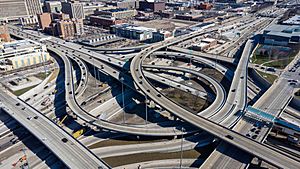
The invention of the automobile changed everything. It marked the end of railroads as the main way people traveled. It started a new age of easy movement in the U.S. Early roads like the Lincoln Highway led to a national highway system in the 1920s. This made cars the main way most Americans traveled. Train services within cities, like trolleys, declined. This was partly because buses became popular and partly due to efforts to remove urban rail lines.
During World War II, car making slowed down. But in the 1950s, the U.S. started building a huge network of fast highways. The most important part is the Interstate Highway system. President Dwight D. Eisenhower started it in the 1950s. It was partly inspired by highways in Italy and Germany.
By 1945, almost every city had an electric tram company for travel within the city. But as more people bought cars, the number of trams dropped a lot by 1965.
Airlines also started to compete with trains for travel between cities. As more airports were built, air travel became easier for everyone. New technology, like jet engines, made flights faster and cheaper. By the late 1960s, flying became so popular that passenger train travel dropped sharply. By the early 1970s, most passenger train services were taken over by government agencies.
Freight railroads also faced challenges as trucks took over more of the business. However, new laws in 1980 helped the railroad industry. In the 1990s, more international trade and container shipping led to a comeback for freight railroads. Today, there are a few large private rail networks across the U.S.
The 21st Century: Modern Transport
In 2014, businesses that move goods and store them employed almost 4.6 million people. This work made up about 9.5% of the U.S. economy. Truck driving is the biggest job in freight transport, with about 2.83 million truck drivers. Most of these drivers operate large tractor-trailer trucks.
In 2014, the U.S. freight system moved a record amount of goods. About 55 million tons of freight, worth $49.3 billion, moved daily. This met the needs of millions of homes and businesses.
Long-distance pipeline transport for oil and natural gas grew a lot in the mid-20th century. Pipelines now carry most of these products across the country.
Road Transportation
Roads and Cars
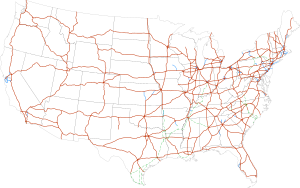
The U.S. relies heavily on cars. About 86% of American workers drive to work. Car ownership is very common, except in the biggest cities like New York City, where many people use mass transit.
The Eisenhower Interstate Highway System, built in the 1950s, made long trips and daily commutes by car very common. This system is over 47,182 miles long. It is the world's second longest highway network and the biggest public works project in U.S. history.
The Interstate system connects almost all major U.S. cities. It helps move many goods and services. Most long-distance travel, for vacations or business, uses this national road network.
Besides the Interstate system, there are U.S. highway system routes. These are joined by state highways and local roads managed by counties and cities. The U.S. has about 4,161,000 miles of roads. About 2,844,000 miles are paved, and 1,317,000 miles are unpaved.
State governments maintain all federal highways. They get federal money to help build and maintain the Interstate network. Many highways, especially on the East Coast and in the Midwest, are toll roads that charge a fee. On the West Coast, highways are usually free to use.
After the I-35W Mississippi River bridge collapsed in Minnesota in 2007, people became more aware of the need to repair roads and bridges. In 2021, President Joe Biden signed a bill that included about $110 billion for roads and bridges.
Seat belt use is required in almost all states and U.S. territories.
Intercity Buses
Greyhound Lines is the biggest intercity bus company in the U.S. It has routes across the country. Many smaller bus companies also exist. Taking an intercity bus is often the cheapest way to travel long distances in the U.S.
Traffic Jams
Traffic jams, especially during rush hour, are a big problem in many large U.S. cities. A 2009 study said that traffic jams cost the U.S. almost $87.2 billion. Drivers waste billions of hours and gallons of fuel each year because of traffic.
The U.S. often tries to fix traffic by making roads wider. From 1993 to 2017, the 100 largest cities added 42% more freeway lanes. But traffic jams still increased by 144%. This is because wider roads can actually encourage more people to drive, a concept called induced demand.
Moving Goods by Truck
The trucking industry moves and delivers goods using large commercial motor vehicles (CMVs). These are usually semi-trucks, box trucks, or dump trucks. A truck driver is someone who drives a CMV for a living.
Trucking is very important to the U.S. economy. Trucks move huge amounts of raw materials, parts, and finished goods across the land. They take items from factories to stores. Trucks are also key for construction, moving rocks, dirt, and concrete. Trucks move most of the freight over land in America.
Drivers of large trucks and buses need a special commercial driver's license (CDL). This requires extra training. Truck drivers must also follow rules about how many hours they can drive. These rules are set by the Federal Motor Carrier Safety Administration (FMCSA).
New technology like computers and GPS has made the trucking industry more efficient. It helps companies operate better and makes drivers' lives easier. New rules in 2006 also helped reduce pollution from diesel trucks, improving air quality.
Road Links to Other Places
The U.S. has road connections to its neighbors:
- With Canada: Yes.
- With Mexico: Yes.
For parts of the U.S. that are not connected by road:
- Alaska: Yes, you can drive through Canada or take the Alaska Marine Highway ferry from Washington state.
- Hawaii: No.
- American Samoa: No.
- Guam: No.
- Northern Mariana Islands: No.
- Puerto Rico: No.
- U.S. Virgin Islands: No.
Traffic Rules
Each state in the U.S. has its own traffic code (set of rules). However, most rules are very similar across states. This helps make sure drivers from one state can easily drive in another. All states recognize driving licenses from other states.
Air Transportation
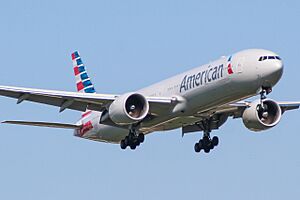

The United States has a very advanced air transportation system. It has about 5,000 paved runways. In 2004, 17 of the world's 30 busiest airports were in the U.S. This included Hartsfield-Jackson Atlanta International Airport, which is the world's busiest airport for passengers. Memphis International Airport was the world's busiest for cargo. Private planes are also used for emergencies, businesses, and individuals.
The U.S. does not have a single national airline owned by the government. All passenger airlines have always been privately owned. There are over 200 domestic (within the U.S.) passenger and cargo airlines. Major international airlines include Delta Air Lines, American Airlines, and United Airlines. Low-cost airlines like Southwest Airlines mostly fly within the U.S.
The federal government sets rules for aircraft safety, pilot training, and accident investigations. The Transportation Security Administration (TSA) handles security at airports.
Rail Transportation
Passenger Trains
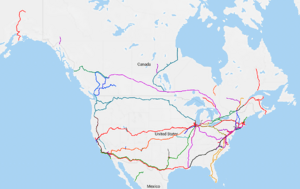
Passenger trains were the main way people traveled until the mid-1900s. But then, jet planes and the Interstate Highway System made train travel less popular. This led to private railroads cutting back on passenger service. So, in 1971, the U.S. federal government created the National Railroad Passenger Corporation, now called Amtrak. Amtrak keeps limited passenger train service running in most parts of the country.
Amtrak serves most major cities. However, outside of the Northeast, California, and Illinois, trains often run only a few times a day. Amtrak does not serve some big places like Las Vegas or Phoenix, Arizona. You can find frequent train service in busy areas like the Northeast Corridor (between Washington D.C., Philadelphia, New York City, and Boston), around Chicago, and in parts of California and the Pacific Northwest.
Private companies stopped running intercity passenger trains in the U.S. in 1983. However, Brightline started private passenger service in South Florida in 2018. The state-owned Alaska Railroad is the only other intercity passenger railroad still running.
City Trains (Rapid Transit)
There are 15 heavy rail rapid transit systems in the U.S. These are like subways. The New York City Subway is the largest rapid transit system in the world by the number of stations.
Cargo Trains
The U.S. uses its rail system a lot for moving freight. U.S. freight railroads are the busiest in the world. They move more freight than all of Western Europe's freight railroads combined!
Almost all railroad tracks, except for local city train systems, are owned by private companies that move freight. Amtrak pays these companies to use their tracks for passenger service. The U.S. has about 150,000 miles of main railroad tracks. This is the longest national railroad network in the world.
Chicago and the Midwest are a major hub for rail freight. About one-third of the nation's freight trains pass through this area. There's a big project underway to improve this part of the rail system.
Train Links to Other Countries
- With Canada: Yes. Amtrak trains run daily between New York City and Montreal, and between Seattle and Vancouver.
- With Mexico: Yes. Some private companies run tourist trains from near El Paso, Texas, into Mexico.
Most U.S. railroads use a standard track width called standard gauge.
Public Transportation (Mass Transit)
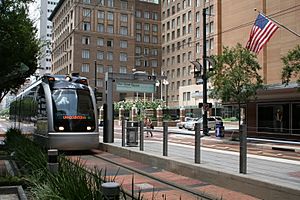
In 2008, the miles people drove in cars went down, while the number of trips taken on public transportation went up. This shows that more people are choosing public transit.
Most medium-sized cities have some kind of local public transportation, usually a network of bus routes. Many older, larger cities also have metro rail systems (like subways) or light rail systems. Newer cities, especially in the Sun Belt, might have smaller light rail systems or no city trains at all.
Laws for Public Transit
Laws are made to help public transportation. For example, in 2008, a law called the Saving Energy Through Public Transportation Act was passed. It gives money to public transit groups to lower fares and expand services. It also helps federal agencies offer transit passes to their employees. The law also helps pay for more parking at the end of subway lines and for buying buses that use alternative fuels.
Water Transportation
Water transport is mostly used for moving freight (goods). There are many fishing and pleasure boats. Passenger ferries connect many islands and remote coastal areas. They also cross lakes, rivers, and harbors. Ferries offer another way to get to Alaska without driving through Canada.
Several major seaports in the U.S. include New York City on the East Coast, New Orleans and Houston on the Gulf Coast, and Los Angeles on the West Coast. The middle of the U.S. also has big shipping channels. These include the Great Lakes Waterway, St. Lawrence Seaway, and the Mississippi River System. Freight on the Mississippi River system is carried on barges pushed by "towboats." This freight is mostly bulk goods like chemicals, grain, and cement.
Many U.S. ports are used by cruise ships. Popular places to visit include the Caribbean, Hawaii, and the Inside Passage to Alaska. Car ferries operate in many places where bridges are not practical or in busy cities like New York City and San Francisco Bay. Washington State Ferries operates ferries in Puget Sound and has one of the largest ferry fleets in the world.
Waterways
The U.S. has about 25,482 miles of navigable inland channels (rivers and canals). About 12,006 miles of these are used for business. The Mississippi River System has about 15,000 miles of navigable waterways. The Saint Lawrence Seaway, which is 2,342 miles long, is shared with Canada.
Ports and Harbors
Here are some major ports and harbors in the United States:
- Anchorage, Alaska
- Baltimore, Maryland
- Boston, Massachusetts
- Charleston, South Carolina
- Chicago, Illinois
- Detroit, Michigan
- Houston, Texas
- Jacksonville, Florida
- Long Beach, California
- Los Angeles, California
- Miami, Florida
- New Orleans, Louisiana
- Newark-New York City
- Philadelphia, Pennsylvania
- Portland, Oregon
- Oakland, California
- San Diego, California
- Seattle, Washington
- Tampa, Florida
- Valdez, Alaska
Merchant Ships

Most goods coming into or leaving the U.S. are carried on foreign ships. However, a law called the Jones Act (from 1920) says that only U.S.-flagged ships can carry goods between U.S. ports. This creates a special "Jones Act fleet" for domestic trade.
Military Transportation
The U.S. military has its own system of bases, runways, aircraft, ships, cars, trucks, and special vehicles. During wartime, the military can take over private transportation if needed.
Pipelines
The U.S. has a vast network of pipelines:
- For Petroleum products: 224,620 km (about 139,572 miles)
- For Natural gas: 548,665 km (about 340,924 miles) (as of 2006)
Transportation Policy
As cities grow, public transportation rules need to change. These rules help keep transportation organized and safe. They aim to reduce accidents and save lives.
Pedestrian Rules
A good city environment supports people walking, biking, skateboarding, and scooting. Rules for pedestrians are set by states. A key rule is that pedestrians usually have the right-of-way. This means if someone is crossing the street, even if they are not in a crosswalk, cars must stop. Drivers should never hit a pedestrian.
However, pedestrians also have rules. They should not step into a crosswalk if a car is too close to stop safely. Pedestrians must also yield to mass transit like trains, as these vehicles are often moving too fast to stop quickly. Pedestrians should not delay traffic more than needed in a crosswalk. When not using a crosswalk, pedestrians must yield to cars that are close enough to be a danger. These rules can be a bit vague, which can sometimes lead to dangerous situations. Future technology, like sensors in cars, might help prevent collisions.
Complete Streets
A "complete street" is a road that is safe for everyone, no matter how they travel or their age. This idea is based on the fact that streets are shared spaces. So, everyone should be able to use them safely. Policies help make sure these streets are well-maintained and used correctly.
- Funding policies decide how state money is used for pedestrian areas, bike lanes, and road markings.
- Planning policies guide how streets are expanded to support human-powered travel and how this fits into city plans.
- Engineering and design policies cover how complete streets are built, like how bike lanes are separated from car lanes.
- Maintenance policies ensure money is set aside to keep streets safe.
- Use policies explain how to use a complete street efficiently for everyone.
Complete streets are important because they support all ways of traveling, make things safer, and help everyone get where they need to go.
Traffic Flow
Rules for traffic flow help make sure traffic moves smoothly and doesn't interfere with walking or public transportation. These rules cover everything from how far apart cars should be on a highway to who has the right-of-way at stop signs and traffic lights. They also cover how to properly use bus, taxi, and carpool lanes.
Parking Lots
Parking rules greatly affect how people travel. Efforts to reduce the amount of space for parking can make people less reliant on cars. This encourages walking, biking, and public transit. It can also lower housing costs and allow more homes to be built in cities. For example, in September 2023, California removed the rule for minimum parking spaces near major public transit stops. Many cities across the U.S. have also changed or removed parking minimums. Some cities, like Nashville, have even started setting maximum parking limits.
How Transportation is Paid For
Most roads are paid for by federal, state, and local taxes. They are usually free for drivers to use. However, some roads and bridges charge a toll. Most other types of transportation charge a fee because they don't get much tax money.
The government helps fund transportation at many levels. The U.S. Congress sets aside money for highways, trains, buses, water, and air travel for several years at a time. Local governments often need to provide some of their own money to match federal grants.
State governments also use their own taxes to help pay for transportation. Different states have different ways of sharing the responsibility for roads and transit between state departments, counties, and cities. Cities or counties usually handle local roads, while the state is in charge of major roads. Many public transit agencies are partly independent and get money from state, county, or city governments.
Economic Impact
The U.S. Department of Transportation (DOT) says that transportation is very important to the U.S. economy. More than $1 out of every $10 produced in the U.S. economy is related to transportation. This includes moving goods, buying transportation products, and people traveling. About 7.4% of all jobs in the U.S. are in transportation.
The United States spends about 0.6% of its total economic output (GDP) on transportation each year.
Environmental Impacts
Two-thirds of the oil used in the U.S. is for transportation. The U.S. also uses a lot of its grain to make ethanol for fuel. In 2008, 18% of U.S. grain went to ethanol.
Carbon Dioxide Emissions
In 2016, transportation became the biggest source of greenhouse gas emissions in the U.S. (28.5%). This was more than electricity generation. In 2019, the transportation sector released 1.8 billion metric tons of carbon dioxide.
- 58% came from personal vehicles (cars, trucks).
- 25% came from commercial trucks and buses.
- 10% came from air travel.
- 3% came from pipelines.
- 2% came from rail.
- 2% came from water transport.
To reduce carbon dioxide from personal vehicles, people can use public transportation more often. Also, choosing active transportation like walking and cycling can reduce pollution to zero. Walking and cycling also help people stay healthy.
Images for kids
See also
- Transportation
- United States Department of Transportation
- Transportation in Canada
- Transportation in Mexico
- List of U.S. cities with high transit ridership
- List of countries by vehicles per capita
- American Public Transportation Association
- History of rail transport in the United States
- Plug-in electric vehicles in the United States
- Road signs in the United States
- Timeline of United States railway history
- Transportation safety in the United States
- Timeline of transportation technology
Specific Locations
- Transportation in Atlanta
- Transportation in Boston
- Transportation in Chicago
- Transportation in Dallas
- Transportation in Los Angeles
- Transportation in New York City
- Transportation in Philadelphia
- Transportation in Portland, Oregon
- Transportation in San Diego
- Transportation in the San Francisco Bay Area
- Transportation in Seattle
- Transportation in Washington, D.C.
Funding Laws
- Surface Transportation and Uniform Relocation Assistance Act
- Intermodal Surface Transportation Efficiency Act
- Transportation Equity Act for the 21st Century
- Safe, Accountable, Flexible, Efficient Transportation Equity Act: A Legacy for Users
- American Recovery and Reinvestment Act of 2009
- Urban Mass Transportation Act of 1964
- Urban Mass Transportation Act of 1970
- National Mass Transportation Assistance Act
- Project Independence


